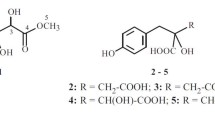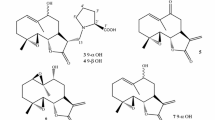Abstract
GC-MS analysis on the essential oil (CC-oil) ofCinnamomum cassia stem bark led to the identification of cinnamaldehyde (CNA,1), 2-hydroxycinnamaldehyde (2-CNA), coumarin (2), and cinnamyl acetate. The major volatile flavor in CC-oil was found to be 2-CNA. Coumarin was first isolated from this plant by phytochemical isolation and spectroscopic analysis. CNA and CC-oil showed potent cytotoxicity, which was effectively prevented by N-acetyl-L-cysteine (NAC) treatment. Intraperitoneal administration with CNA considerably decreased malondialdehyde (MDA) formation and glutathione S-transferase activity in rats. These results suggest that CC-oil and CNA can regulate the triggering of hepatic drugmetabolizing enzymes by the formation of a glutathione-conjugate.
Similar content being viewed by others
References
Bang, K. H., Lee, D. W., Park, H. M., and Rhee, Y. H., Inhibition of fungal cell wall synthesizing enzymes bytrans-cinnamaldehyde.Biosciecnce and Biotechnological Biochemistry, 64(5), 1061–1063 (2000).
Bidlack, W. R. and Lowery, G. L., Multiple drug metabolism: P-nitroanisole reversal of acetone enhanced aniline hydroxylation.Biochem. Pharmacology, 31, 311–317 (1982).
Denizot, F. and Lang R. J., Rapid colorimetric assay for cell growth and survival: modification to the tetrazolium dye procedure giving improved sensitivity and reliability.J Immuno. Methods., 89, 271–277 (1996).
Dillon, D., Combes, R., Zeiger, E., The effectiveness of Salmonella strains TA100, TA102 and TA104 for detecting mutagenicity of some aldehydes and peroxides.Mutagenesis, 13(1), 19–26 (1998).
Habig, W. H., Pabist, M. J., and Jakoby, W. B., Glutathione S-transferase: The first enzymatic step in mercapturic acid formation.J. Biol. Chem., 249, 7130–7139 (1974).
Kwon B. M., Lee S. H., Choi S. U., Park, S. H., Lee, C. O., Cho, Y. K., Sung, N. D., and Bok, S. H., Synthesis and in vitro cytotoxicity of cinnamaldehyde to human solid tumor cells.Arch. Pharm. Res., 21(2), 147–152 (1998).
Lee, C. W., Hong, D. H., Han, S. B., Park S. Y., Kim, H. K., and Kwon, B. M., Inhibition of human tumor growth by 2′-hydroxy- and 2’-benzoyloxycinnamaldehyde.Planta Medica, 65, 263–266 (1999).
Nash, T., The colorimetric estimation of formaldehyde by means of the hantzsch reaction.J. Biol. Chem., 55, 416–422 (1953).
Ohkawa, H., Ohishi, N., and Yagi, K., Assay for lipid peroxides in animal tissue by thiobarbituric acid reaction.Anal. Biochem., 95, 351–358 (1979).
Stirpe, F., and Delia, C. E., The regulation of rat liver xanthine oxidase: Conversion in vitro of the enzyme activity from dehydrogenase (Type D) to oxidase (Type O).J. Biol. Chem., 244, 3855–3863 (1969).
Rajagopalan, K. V., Fridovich, I., Handler, P., Palmer, G., and Beinert, H., Studies of aldehyde oxidase by electron paramagnetic resonance spectroscopy.J. Biol. Chem., 243, 3783–3796 (1968).
Tang, W. and Eisenbrand, G., Chinese Drugs of Plant Origin, 319–330 Sringer-Verlag, Berlin (1992).
Author information
Authors and Affiliations
Corresponding author
Rights and permissions
About this article
Cite this article
Choi, J., Lee, KT., Ka, H. et al. Constituents of the essential oil of theCinnamomum cassia stem bark and the Biological Properties. Arch Pharm Res 24, 418–423 (2001). https://doi.org/10.1007/BF02975187
Received:
Issue Date:
DOI: https://doi.org/10.1007/BF02975187




